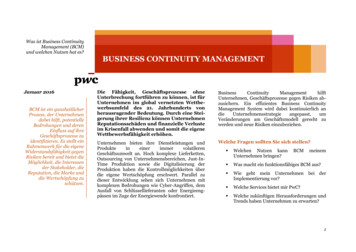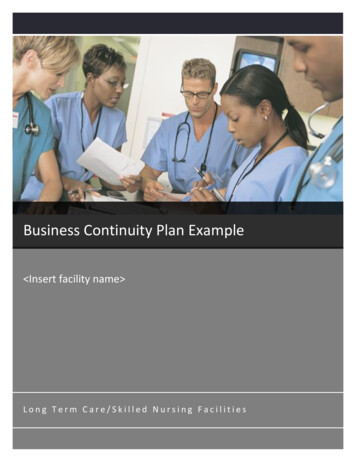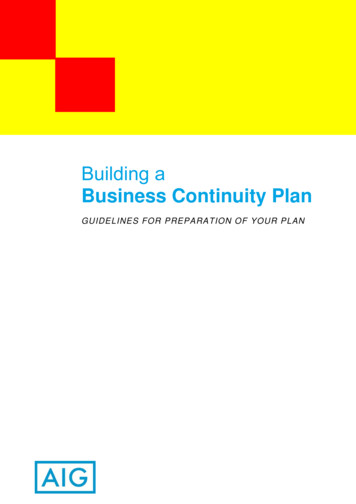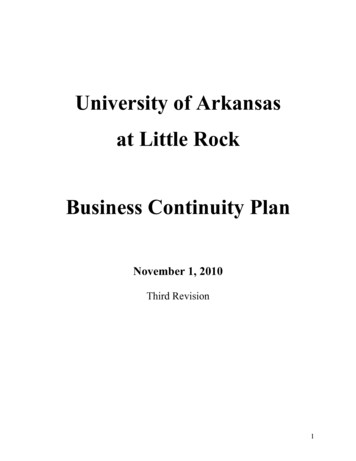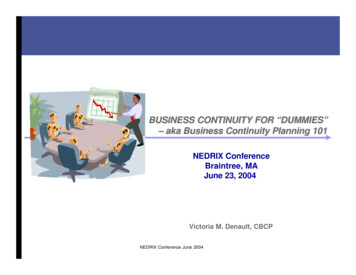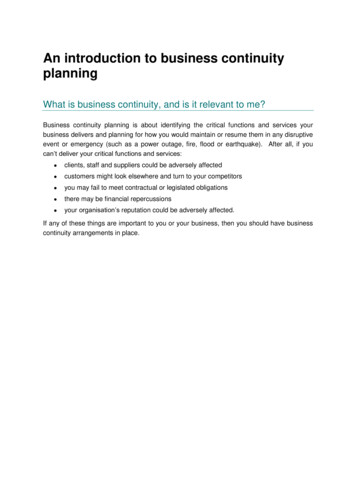
Transcription
RiskSOURCEClark-ThedersPlanThe information contained in this toolkit is not intended to be used as legal advice. The reader should consult legal counselregarding specific legal issues. 2014 Zywave Inc. All Rights Reserved.
PlanWhat is business continuityplanning?Business continuity planning is the processof identifying the parts of your company thatare most vulnerable in order to create a planto recover them if a business interruptionoccurs. Your company’s business continuityplan, in conjunction with businessinterruption insurance, form your businesscontinuity management (BCM) program.Businesses with strong BCM programs aremore resilient in the face of emergenciesand disasters.The steps involved in creating, implementingand maintaining a business continuity planare listed to the right. The process ofcreating the plan is in itself a beneficialexercise. The resulting plan, if implementedand maintained, can be the differencebetween recovering from a businessinterruption and going out of business.Why is continuity planningimportant?Did you know that 1 out of every 4 businesses impacted by a disaster never reopens its doors? And in the past year,nearly 1 in 5 companies has reported experiencing a business interruption. A business interruption can be as benignas a short power outage or as severe as a hurricane. Companies that are prepared to face all types of incidents—small or large—are more likely to stay in business.How do I use this sample plan?This document is a template to help you begin the continuity planning process for your company. Sample text hasbeen provided for the majority of the sections to serve as a starting point. You will want to review all of this sampletext and customize it to fit the needs of your company. Any text listed in red must be replaced with company-specificinformation.This document pairs nicely with another tool: the Business Continuity Planning Toolkit. The Toolkit providesdescriptions of the purpose of each section of your continuity plan. It follows the same format as this sample plan.Refer to the Business Continuity Planning Toolkit for additional instructions and guidance as you customize thissample plan.You will likely find that you need to communicate with other departments or internal resources to gather the materialsnecessary to complete some sections of the plan. There is no need to complete the plan in the order it is listed in thissample. Customize and adapt this sample to fit the needs of your business. If you have questions as you work,contact your RiskSOURCE Clark-Theders representative.1
PlanTable of ContentsDirection and Control . 3Business Mission Statement . 4Business Continuity Policy . 4Emergency Management Group . 4Incident Commander . 5Team Processes and Procedures . 5Incident Commander Workflow . 5Emergency Operations Center . 6Communication . 7Emergency Communications . 8Notification . 8Warning . 8Confidentiality Requirements . 9Organizational Chart . 9Customer Lists . 9Utility Provider Information . 9Suppliers and Equipment Providers . 9Life Safety . 10Evacuation Planning . 11Assembly and Accountability . 11Shelter . 11Employee Training . 12Family Preparedness . 12Property Protection . 13Protection Systems . 14Mitigation . 14Facility Shutdown . 15Records Preservation . 15Building Information . 16Community Outreach . 17Mutual Aid Agreements . 18Public Information . 18Media Response . 18Local Emergency Information . 19Recovery and Restoration . 20Procurement, Logistics and Distribution . 21Operations. 21Product or Service Development . 22Marketing, Sales and Customer Accounts . 22Customer and Aftersales Services . 23General Management and Firm Infrastructure . 23Human Resource Management . 24Technology and Process Development . 24Implementation and Maintenance . 25Integrate the Plan into Company Operations . 26Business Interruption Insurance . 26Conduct Drills and Exercises . 26Train Employees . 27Annual Plan Audit. 28Appendix . 292
PlanDirection andControl3
PlanBusiness Mission Statement Company mission statement Business Continuity PolicyThe purpose of the business continuity policy is to maintain business functions in the event of an emergency. Thepolicy applies to , its subsidiaries, all locations and all employees.In the event of an emergency, the Emergency Management Group will be responsible for declaring emergencies,evacuating or shutting down facilities as necessary and contacting employees. The Emergency Management Groupwill be led by the Incident Commander and will operate out of the designated Emergency Operations Center.The Emergency Management Group has the authority to identify critical business functions impacted by theemergency and initiate the process for recovering each function in the order laid out in the Business Continuity Plan.The Business Continuity Plan is enacted with the purpose of ensuring continued business activity in the event of anemergency and ensuring the safety of all employees. Failure to comply with the Business Continuity Plan or anydirectives issued by the Emergency Management Group may result in verbal reprimands, official write-ups andtermination, as deemed appropriate.Emergency Management GroupThe Emergency Management Group is responsible for controlling all technical aspects of emergency response. Thegroup will be led by the Incident Commander. Members of this group (and only these designated members) have theauthority to:-Order facility shutdown-Initiate evacuation of employees and customers-Declare that an incident has ended-Communicate with the media-Initiate the emergency response phone treeThe following employees comprise the Emergency Management Group:- Employee name and role - Employee name and role - Employee name and role - Employee name and role In the event that these individuals are not available, the following employees may serve as alternative members ofthe Emergency Management Group:- Employee name and role - Employee name and role 4
PlanIncident CommanderThe Incident Commander is responsible for communicating with internal and external resources in the event of anemergency. This individual has the authority to declare an emergency, shut down company facilities andcommunicate with the media.- Employee name is the Incident Commander.-In the event that Employee name is not available, Employee name shall serve as the Incident Commander.Team Processes and Procedures Team processes and procedures Incident Commander WorkflowIn the aftermath of an emergency, immediately take the following steps to resume operations:-Organize a recovery team and list your business' top priorities for resuming operations.-Ensure the safety of personnel on the property by evaluating any remaining hazards and controlling security at thescene of the incident.-Conduct an employee briefing.-Maintain detailed records. Record all decision making and videotape or photograph the damage.-Account for all damage-related costs by establishing charge codes for purchases and repair work.-Follow your notification procedures. Notify employees' families about on-duty personnel, notify off-duty personnelabout their work status and alert insurance carriers and appropriate government agencies.-Protect undamaged property by closing building entrances and exits, restoring sprinkler systems, re-establishingpower, guarding property against moisture and removing smoke, water and general debris.-Coordinate your restoration actions with appropriate government agencies.-Regulate salvage operations by segregating damaged property from undamaged property and retaining damagedgoods until an insurance adjuster can view them. However, you should move material outside if it impedes trafficand can withstand exposure to the elements.-Perform an inventory count on damaged goods with an adjuster or the adjuster's salvor. Obtain a signed inventorylisting the quantity and type of goods if you release any to the salvor.-Restore equipment and property. Do not undert
What is business continuity planning? Business continuity planning is the process of identifying the parts of your company that are most vulnerable in order to create a plan to recover them if a business interruption occurs. Your company’s business continuity plan, in conjunction with business interruption insurance, form your business
